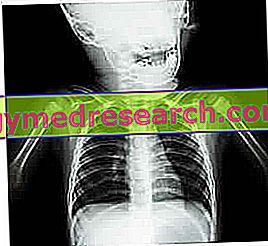Generality
Neuroblastoma is a rare malignant tumor that originates from immature nerve cells called neuroblasts. Usually (70% of cases) it develops in the abdomen - in particular behind the adrenal glands - but it can also be located at the level of the chest (19% of cases), on the neck or on a point of the spine.

The symptomatology - which largely depends on the site of the neuroblastoma - is initially somewhat vague; becomes evident over time, when the tumor mass grows.
The most feared complication is the spread of metastases from the tumor.
Only through an accurate diagnostic procedure can the most appropriate therapy be established.
The treatments available today consist of surgery to remove the tumor mass, chemotherapy and radiotherapy.
A brief review of what a tumor is
In medicine, the term tumor identifies a mass of very active cells, able to divide and grow uncontrollably.
There are two types of tumors: benign forms and malignant forms.
Benign tumors are cellular masses whose growth is not infiltrative (that is, it does not invade the surrounding tissues) and even metastasizing.
Malignant tumors, on the other hand, are clusters of cells capable of growing very quickly and spreading to the surrounding tissues and to the rest of the body (via the blood and / or lymphatic circulation).
The words malignant tumor, cancer and malignant neoplasia are to be considered synonymous.
What is neuroblastoma?
Neuroblastoma is a malignant tumor (and therefore a cancer) that develops from neuroblasts and can be located in various parts of the body.
Neuroblasts are particular immature nerve cells, that is not yet differentiated. In general, with their presence, they characterize the fetal and neonatal phase of life; after which they mature and become, for example, real nerve cells.
Meaning of the word neuroblastoma
The word neuroblastoma is composed of three parts:
- Neuro, which refers to nerve involvement.
- Blasto, which means "cell in an early stage of development" or "undifferentiated cell".
- Oma, which indicates the characteristic presence of a group of cells, or a tumor.
LOCALIZATION OF A NEUROBLASTOMA
Neuroblastomas generally form in the abdomen, at the level of the adrenal glands (also called adrenal glands ) or the tissues surrounding the latter.

Furthermore, since they are malignant and therefore metastasizing tumors, they can spread elsewhere, for example, "moving" from the abdomen to the bones, liver or skin layers.
Epidemiology
Since it originates from cells present above all in the first years of life, neuroblastoma is a malignant neoplasm typical of early childhood. In fact, it corresponds to 6-10% of all tumors that affect children and 15% of all malignant tumors of young age.
Individuals within the 2nd year of life suffer the most.
As age progresses, the incidence of neuroblastoma decreases progressively. Moreover, according to some estimates, only 10% of sufferers are over 5 years old.
Neuroblastoma is a fairly rare cancer: in a country like the United States there are 650 cases a year, while in the United Kingdom about a hundred.
Recent research, conducted in Europe, revealed that of the 4000 cases of registered neuroblastoma, less than 2% involved people over the age of 18.
Causes
Tumors are usually the result of a series of genetic mutations affecting cell DNA.
These mutations - which usually involve a single cell, from which other mutated cells originate through mitosis - are responsible for the uncontrolled process of cell division and growth, typical of a tumor mass.
Neuroblastoma is not an exception to this rule: it appears following a genetic mutation of the DNA contained in a neuroblast, which, after the aforementioned mutation, begins to divide unceasingly and without the possibility of arrest.
ORIGIN OF MUTATIONS
Despite numerous studies conducted in this regard, researchers have not yet succeeded in establishing the precise causes of neuroblastoma.
RISK FACTORS
After finding that some patients with neuroblastoma had blood relatives with the same disease, scholars formulated the thesis that, for some, there is a certain family predisposition to neuroblastoma.
According to some hypotheses, this family predisposition would result from the hereditary transmission, at the moment of conception, of a mutation favoring the malignant neoplasm in question.
Symptoms and Complications
To learn more: Neuroblastoma symptoms
The symptoms and signs of a neuroblastoma vary depending on where it arises and where it spread its metastases.
Neuroblastomas with home sites in the abdomen - which account for about 70% of cases - cause:
- Abdominal pain and distention.
- Appearance of a subcutaneous mass of rigid consistency (not soft). It's the tumor.
- Intestinal problems, such as tendency to diarrhea and / or bladder problems.
- Swollen abdomen.
- Swelling of the legs.
Neuroblastomas arising in the chest (19% of cases) and the neck may be responsible for:
- Wheezing and wheezing during breathing.
- Chest pain.
- Eye problems, including the so-called waning eyelids, a different size of the two pupils (anisocoria), appearance of black marks similar to hematomas around the eyes and proptosis.
- Swelling of the face, arms or upper chest.
- Presence of a rigid mass to the touch, in a place of the chest or neck. It's the tumor.
- Headache, dizziness and changes in the state of consciousness.
- Inability to move the upper and / or lower limbs. This is because the tumor mass compresses the nerve pathways that control the arms and hands.
The neuroblastomas formed near the vertebral column cause compression against the column itself. Such compression involves the appearance of problems in walking, in proceeding on all fours or standing.
OTHER SYMPTOMS
Whether they are located in the abdominal area or in other areas of the body, almost all neuroblastomas have a tendency to cause loss of appetite, fever, fatigue and malaise .
Moreover, very often they are also characterized by increasing catecholamine production . Catecholamines are chemical molecules, generally with hormonal function, which derive from the amino acid tyrosine. They are involved in many physiological processes: for example, two of the best known catecholamines, adrenaline and noradrenaline, intervene in the reactions defined with the term "fight and run".
Some symptoms related to the increase in circulating catecholamines:
- Weight loss
- Unusual sweating
- Hot flushes and skin redness
- Diarrhea
- Increased heart rate and blood pressure
EVOLUTION OF SYMPTOMS
In its early stages, a neuroblastoma presents with just a hint of symptoms and little significance. In fact, those who suffer from it tend to suffer from a slight fever and to appear tired and not very hungry.
In the later stages of the disease, the situation changes markedly and the patient manifests the symptoms reported for tumors located in the abdomen, thorax etc.
Attention : the accurate analysis of numerous clinical cases has revealed that many neuroblastomas, when the symptoms become evident, have already given rise to metastases (ie they have contaminated other organs or tissues of the body with their cancer cells).
COMPLICATIONS
The most important and feared complication of a neuroblastoma is the spread, by the tumor and through the blood or lymphatic circulation, of metastasis . The latter can affect:
- The bones, inducing the appearance of pain and difficulty in walking
- Bone marrow, causing anemia, tendency to haemorrhages, hematomas and infections (due to the lack of white blood cells in the circulation)
- The skin, giving rise to bleeding and bruising.
Another important complication that deserves to be reported is the so-called paraneoplastic syndrome . It is a set of disorders associated with the presence of cancer, which occurs regardless of the presence of metastatic elements.
Those who suffer from paraneoplastic syndrome can also report problems in organs that are very distant from where the tumor has arisen.
WHEN TO REFER TO THE DOCTOR?
It would be desirable to identify a neuroblastoma at the beginning, as it would mean that the tumor is most likely still confined to a circumscribed site.
Unfortunately, however, this is complicated by the fact that the initial symptoms are insignificant and difficult to detect.
Diagnosis
The diagnostic procedure for the detection of a neuroblastoma includes:
- A thorough physical examination
- Blood and urine tests
- Diagnostic imaging tests
- A tumor biopsy
- The collection of a bone marrow sample and its subsequent analysis in the laboratory.
EXAMINATION OBJECTIVE
A thorough physical examination consists of a careful analysis of the symptoms and signs shown by the patient.
Since the sick are generally very young children, the doctor very often needs to question the parents: only in this way can he get a complete picture of the symptoms.
EXAMINATION OF BLOOD AND URINE
Through blood and urine tests, the doctor can see if the presumed tumor has caused alteration of some physiological parameters.
They are the ideal tests to recognize an abnormality in catecholamine levels.
EXAMS OF DIAGNOSTICS FOR IMAGES
Diagnostic imaging exams are very useful, because they allow the identification of the tumor mass and some of its characteristics (such as the site and size).
In general, the diagnostic imaging procedures provided are:
- X-rays . Referred to the area where neuroblastoma is presumed to be present, they represent a painless diagnostic method, which however exposes the patient to a (very small) dose of ionizing radiation.

- Ultrasound . It consists of the use of an ultrasound probe, which, in contact with the skin, projects the appearance of the underlying tissues onto a connected monitor. It is a painless procedure and completely free of side effects.
- CT scan (computerized axial tomography) . It is a method that uses ionizing radiation to build a highly detailed three-dimensional image of a given bodily behavior. It is completely painless, but the dose of X-rays to which patients are exposed is remarkable.
- Nuclear magnetic resonance (RMN) . It is based on the use of an instrument that generates magnetic fields and is able, thanks to the latter, to create a precise image of the internal parts of the human body. It is painless and, unlike the TAC, does not foresee dangerous exposures. In fact, the magnetic fields generated by the equipment are not harmful.
- Scan with Meta-Iodo-Benzil-Guanidina (MIBG) . MIBG is a substance that is easily absorbed by the cells that make up neuroblastomas. Therefore, it was thought to use it as a diagnostic tool. For this purpose, it is enriched with radioactive iodine, visible with an appropriate instrument, and injected directly into the patient's blood.
TUMOR BIOPSY
A tumor biopsy consists in the collection and histological analysis in the laboratory of a sample of cells from the tumor.
For diagnostic purposes, it is the exam that provides the most useful information. It allows, in fact, to establish at what stage of gravity the neuroblastoma has arrived.
WITHDRAWAL OF THE BONE MARROW
The collection and analysis in the laboratory of a bone marrow sample allow us to discover if the neuroblastoma has spread some of its metastases in this area.
The collection of the material to be analyzed takes place after general anesthesia and involves the use of a special needle inserted in the iliac crests or in the lower back.
GRAVITY OF A NEUROBLASTOMA: THE TUMOR STAGES
The severity of a tumor depends on the size of the neoplastic mass and the ability of the tumor cells to spread. There are 4 main stages of gravity:
- Stage I (or stage 1 ).
Neuroblastomas at this stage are located at a certain point and have well-defined contours. Representing the less severe form of the disease, they lend themselves sufficiently well to complete surgical removal.
The only lymph nodes that could present some tumor cells within them are those closely related to the tumor. All the others are completely healthy.
- Stage II (or stage 2 ).
There are two stage II subtypes: the IIA stage and the IIB stage.
In both cases, neuroblastomas are localized and not very common. The only difference between the two stages lies in the possibility of surgical removal: an IIA neuroblastoma is not completely removable, while a IIB neuroblastoma can also be removed completely.
At stage II, cancer cells certainly invade the lymph nodes connected to the tumor and, sometimes, even those located a short distance away.
- Stage III (or stage 3 ).
A stage III neuroblastoma is a somewhat advanced, large and impossible to surgically remove malignant tumor.
Nevertheless, it is not said that it has disseminated some metastases to other parts of the body.
The only lymph nodes that surely contain cancer cells are those connected directly to the tumor.
- Stage IV (or stage 4 ).
As in the case of stage II, there are two stage IV subtypes: the IVM stage and the IVS stage.
IVM stage neuroblastomas represent the most severe form of the disease. They are in fact large malignant tumors, characterized by metastases in different parts of the body. At this stage, both the lymph nodes connected to the tumors, and the lymph nodes more distant from the tumor site, show traces of tumor cells.
Obviously, the possibilities of treatment for an IVM stage neuroblastoma are indeed very limited.
Turning then to stage IVS neuroblastomas, these are less severe malignant tumors than one might think. Typical of children under the age of life, they are responsible for metastasis in the skin, liver and bone marrow, but can nevertheless be treated satisfactorily.
At the moment, researchers are trying to understand the reason for such abnormal behavior.
Knowledge of the neuroblastoma stage is essential for the most appropriate treatment planning.
Another classification of neuroblastomas
In 2005, the representatives of the most important pediatric oncology centers in the world met to discuss also a new method of classification of neuroblastomas (alternative to that of the 4 stages just described).
At the end of the meeting they decided that a neuroblastoma can be distinguished according to three risk levels: low, intermediate and high.
Treatment
The therapy of a neuroblastoma depends on:
- The tumor stage . For stage I cancer, the chances of treatment are higher than for stage III or IV cancer.
- The tumor grade . By tumor grade we mean the growth rate of a tumor. Neuroblastomas with a speed of growth that is not particularly high are more easily treated than neuroblastomas with very rapid growth.
The adoptable treatment methods are: surgery, chemotherapy and radiotherapy .
It is rare that they are applied individually; in fact, for a better result, one can resort for example to surgery and several cycles of chemotherapy.
Special case
Stage IVS neuroblastomas can, in some cases, heal on their own. It is possible, in fact, that the tumor resolves spontaneously, without resorting to any surgical, chemotherapeutic or radiotherapeutic therapy.
SURGERY
The purpose of surgery is to remove all the neuroblastoma or most of this, if total excision is impossible.
The exact method of intervention depends largely on the location and size of the tumor.
Unfortunately, there are neuroblastomas that have reached such a stage that they are inflexible (stage III and IVM). In these situations, the only solution is to rely exclusively on chemotherapy and radiotherapy.
Obviously, when we talk about neuroblastoma removal surgery, we also refer to the removal of lymph nodes containing tumor cells. If these were not removed, the risk of relapses (or relapses) would be very high.
The most difficult neuroblastomas to be removed are those located near some vital organs, such as the lungs (thoracic neuroblastoma) or the spinal cord (neuroblastoma of the spine).
CHEMOTHERAPY
Chemotherapy consists of the administration of drugs capable of killing all rapidly growing cells, including cancer ones.
In the case of neuroblastoma, it is adopted in the following situations:
- Before surgery, if your doctor thinks that taking chemotherapy may facilitate tumor removal.
- Whether neuroblastoma has invaded surrounding tissue areas and / or has spread metastasis to other parts of the body.
- If surgical removal was partial.
- In the presence of a tumor recurrence or when the risk of such an event is very high.
- Instead of surgery, if it is impossible. In general, chemotherapy is combined with radiotherapy.
High doses of chemotherapy drugs can severely damage the bone marrow, thus compromising the normal production of blood cells. To cope with this problem, at the end of chemotherapy, doctors plan a cure to restore normal bone marrow function.
RADIOTHERAPY
Tumor radiotherapy is the treatment method based on the use of high-energy ionizing radiation, with the aim of destroying the neoplastic cells.
In the case of neuroblastoma, radiotherapy may be used on the following occasions:
- Before surgery, if the treating physician believes that radiotherapy treatment can simplify the removal operation.
- In the presence of a tumor recurrence.
- If the surgical removal was partial.
- Instead of surgery, if it is impossible. In these situations, it is essential to combine radiation therapy with chemotherapy.
Main side effects of radiotherapy | Main side effects of chemotherapy |
Fatigue itch Hair loss | Recurring fatigue and sense of fatigue Malaise characterized by nausea and vomiting Hair loss Vulnerability to infections |
Prognosis
The prognosis in the case of neuroblastoma depends on at least three factors:
- Age of the patient . Very young children with neuroblastoma are more likely to survive.
- Stage and degree characterizing the tumor . The reasons are those already discussed above: a stage I neuroblastoma can also be completely removed, therefore the carriers of such a tumor have higher hopes to completely recover.
- Absence of the MYCN mutated gene . The researchers noted that neuroblastoma cells, which are mutated in the MYCN gene, are highly malignant.




